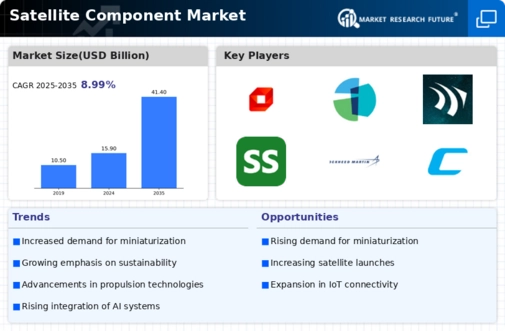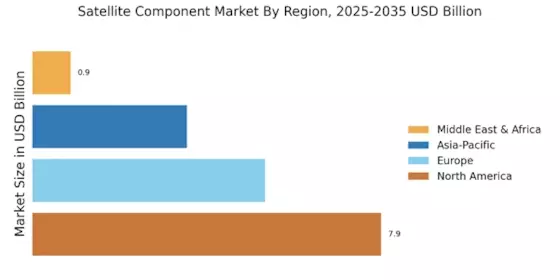Emergence of New Market Players
The Satellite Component Market is witnessing the emergence of new market players, which is fostering competition and innovation. Startups and established companies alike are entering the market with novel solutions and technologies aimed at addressing specific needs within the satellite ecosystem. This influx of new entrants is likely to drive down costs and enhance the quality of satellite components, as companies strive to differentiate themselves. Furthermore, the collaboration between traditional aerospace firms and tech startups is creating synergies that could lead to groundbreaking advancements in satellite technology. As a result, the Satellite Component Market is poised for dynamic growth, characterized by a diverse range of offerings.
Increased Government Investments
Government investments in space exploration and satellite technology are significantly influencing the Satellite Component Market. Various nations are allocating substantial budgets to enhance their satellite capabilities, driven by strategic interests in national security, scientific research, and technological leadership. For example, recent reports indicate that government spending on satellite systems is projected to grow by approximately 5% annually, reflecting a commitment to advancing space infrastructure. This influx of funding is likely to stimulate innovation within the Satellite Component Market, as companies strive to meet the evolving demands of government contracts and projects.
Advancements in Satellite Technology
Technological advancements play a pivotal role in shaping the Satellite Component Market. Innovations such as miniaturization, improved propulsion systems, and enhanced payload capabilities are transforming satellite design and functionality. The introduction of new materials and manufacturing techniques has led to lighter and more efficient components, which are essential for modern satellite applications. For instance, the adoption of additive manufacturing techniques has reduced production costs and timeframes, allowing for rapid prototyping and deployment. As a result, the Satellite Component Market is witnessing a shift towards more sophisticated and capable satellite systems, which are expected to dominate the market in the coming years.
Growing Demand for Communication Satellites
The Satellite Component Market is experiencing a notable surge in demand for communication satellites. This growth is primarily driven by the increasing need for high-speed internet connectivity and enhanced communication services across various sectors. As of 2025, the demand for satellite communication is projected to reach unprecedented levels, with an estimated market value exceeding 100 billion USD. This trend is further fueled by the expansion of 5G networks, which necessitate advanced satellite components to ensure seamless connectivity. Consequently, manufacturers are focusing on developing innovative components that can support the growing infrastructure requirements of communication satellites, thereby propelling the Satellite Component Market forward.
Rising Demand for Earth Observation Satellites
The Satellite Component Market is also experiencing a rising demand for earth observation satellites, driven by the increasing need for data related to climate change, agriculture, and urban planning. As of 2025, the market for earth observation satellites is expected to grow significantly, with a projected value of over 30 billion USD. This demand is prompting manufacturers to develop specialized components that can enhance the capabilities of these satellites, such as high-resolution imaging systems and advanced sensors. Consequently, the Satellite Component Market is adapting to meet the specific requirements of earth observation applications, which are becoming increasingly critical in various sectors.


















Leave a Comment